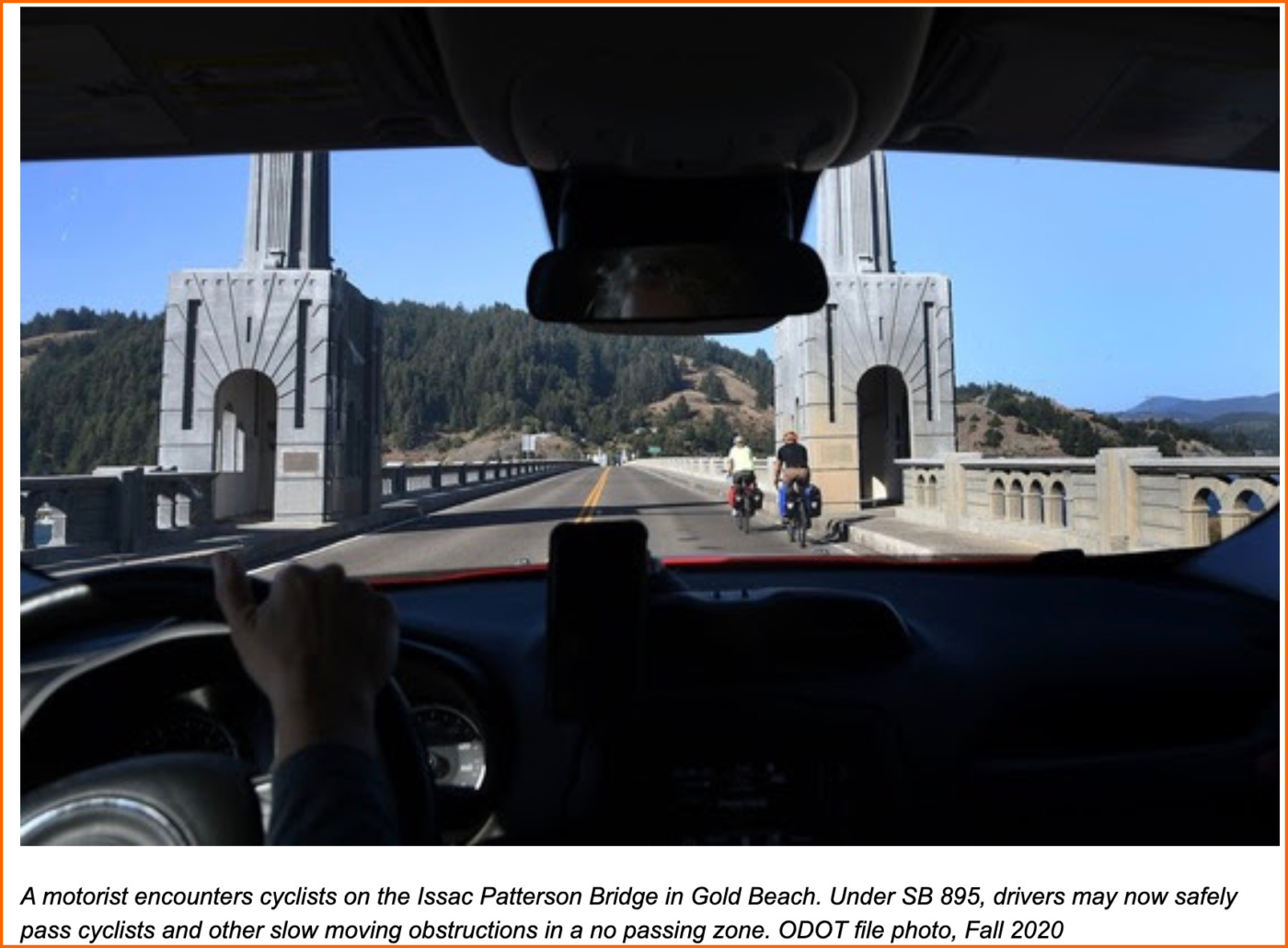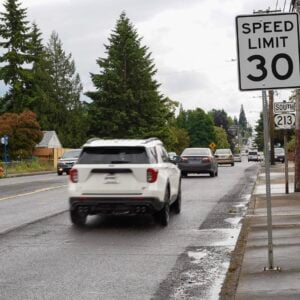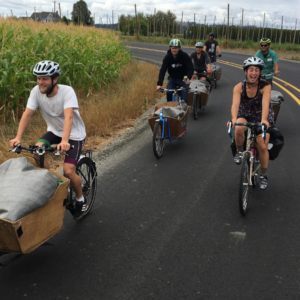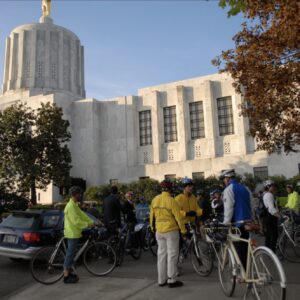The first day of the new year following a regular Oregon legislative session is always fun because that’s typically when new laws go into effect. In 2023, several notable transportation-related laws were passed and are now laws of the land. I’d been meaning to round them up when, lo and behold, the Oregon Department of Transportation sent out a press release today with a handy summary.
ODOT framed the new laws as important progress for road safety. And I agree with them! Three of them in particular are safety-related laws you should be aware of. And a fourth is more of a technical policy change that will have safety implications down the road.
Below (via the ODOT press release) are four noteworthy new laws now in effect in Oregon that will impact our streets:
- HB 2095 – Gives all cities in Oregon the authority to use mobile photo radar for traffic enforcement – as long as they pay their own operational costs – and removes limits on the number of hours it can be used. The bill also allows cities to lower the speed limit on certain streets at up to 10 miles below the statutory speed (but not less than 20 mph).
- HB 2316 – The bill changes definitions and potential penalties for driving under the influence of intoxicants. An “intoxicant” now includes any substance, or combination of substances, that can cause mental and physical impairment. Previously, the definition included only alcohol, cannabis, psilocybin, and controlled substances. Some fines are reduced for people convicted of DUII while riding a bicycle.
- HB 2099 — The bill makes a variety of changes to transportation laws but notably updates ODOT’s Safe Routes to School program. The bill increases the eligibility radius for Safe Routes to School projects from one mile to two miles, ensures projects serving high schools are equally considered with elementary and middle schools, and allows greater flexibility in determining the grant match requirement for individual projects.
- SB 895 – Allows drivers to pass in a no passing zone if the driver encounters an obstruction, including a bicycle or other vehicle traveling at a speed of less than half the posted speed limit. The driver must ensure there are no oncoming vehicles and stay at least 5 mph under the posted speed limit while passing.
I really like the bicycling under the influence law changes. Whenever the legislature recognizes the vast difference between cars and bicycles in terms of their respective ability to do harm to others, it’s a win for everyone. A similar line of thinking applied to the fight to change the stop sign law for bicycles (a.k.a. “Idaho Stop”). Since bicycle riders have such a different vehicle and operational context, the thinking went, why should they be required to do the same behavior as car drivers at stop signs?
As for the safe passing law, I really hope ODOT makes a concerted effort to educate the community (police, the public, the media) about it. While I think the changes to the law are excellent news, I worry that it will be something hardly anyone understands or knows about.
And of course not mentioned here is HB 3014, the “bike bus bill,” that also passed in 2023. We covered that one in depth and it remains to be seen how/if it has a big impact on how schools spend education funds. I look forward to tracking it and reporting back.







Thanks for reading.
BikePortland has served this community with independent community journalism since 2005. We rely on subscriptions from readers like you to survive. Your financial support is vital in keeping this valuable resource alive and well.
Please subscribe today to strengthen and expand our work.
I’m sorry but giving any more “pass” to drivers that already ignore the ones we have is a recipe for more disaster IMO.
It reopens even more the can of worms that already fails to hold drivers accountable as it did with the teacher from Vancouver that even with an eyewitness failed, again.
This is about revenue. C’mon man!
Considering drivers already (illegally) pass bikes in the lane in no passing zones, I’m having a hard time imagining what exactly SB 895 changes (for the better). It’s not like it makes it extra illegal to pass a bike going say 25 MPH in the lane in a 30 MPH zone. Generally it makes it more legal to pass people in no passing zones.
Apologies if I’m misunderstanding something, but it seems more like it codifies existing behavior and will make it less illegal to pass a bike taking the lane in a no passing zone.
If enforced/educated, I think SB 895 could improve conditions for people on bikes, and accountability for car drivers. Most drivers won’t think twice about crossing a double-yellow to pass a bike rider, even with oncoming traffic. In most cases, I’d have little issue with folks carefully considering a pass, and then doing so at 5mph below the speed limit. I’d be much happier if drivers passing in a 30mph zone were doing so at 25mph vs the 35-45mph they were probably going already. I think the law does a good job at specifically outlawing the more egregious behaviors that result from most people’s if-bike-then-pass default programming.
Also, this sort of makes it mathematically illegal to pass in a 20mph zone. By the law, if the bike rider is going >10mph, the car driver is not legally allowed to pass. Say the bike rider is going 15mph, there’s no physical way the driver can pass if they were to slow down to 5 under to pass. Not saying drivers will stop trying to pass on greenways and other slow-speed streets, but at least now it is actually illegal to do so.
I don’t foresee lots of tickets/warnings being issued, but at least there is a more codified definition of a safe pass if an incident were to occur. I almost wish I could ride around with SB 895 flyers to pass out when I inevitably catch up to a passing driver at the next red light…
The “obstruction” has to be traveling at less than half the posted limit for the law to even trigger, so that would rule out most situations in 20 or even 25mph zones.
Minor point, but It seems like passing in a 20 mph zone would be legal under the bill if the person in a bike is slower than 10 mph (and the driver does not go faster than 15 mph when passing).
There was a case a few years back out in North Plains where some local maniac was harassing and intimidating riders because he was adamant that he couldn’t pass cyclists over the double yellow. He would follow closely, honk, and yell at cyclists to pull onto the shoulder. This will clear up situations like that.
Honestly the part about staying 5 mph below the speed limit seems dangerous to me. This law seems more aimed at rural highways where no passing zones are typically in place because you can’t see oncoming traffic well. If you’re on a rural highway with a 50 mph speed limit it’s dangerous to be in the oncoming lane and the longer someone takes to pass the more likely they’ll encounter oncoming traffic, so forcing drivers to pass slowly could increase the danger.
Or they can wait for a safe opportunity to pass. If it is a blind corner or some situation where they would not have enough time to pass if there was an oncoming vehicle, then they can slow down and wait for a better opportunity. It sucks for drivers on rural uphills with windy roads, since they may have to wait up to a whole minute. Imagine the trauma.
The time you’re in the oncoming lane is determined by your speed and the speed of the thing you’re passing, so it should be fine to slow down. (If you’re passing something slow, you’ll be in the oncoming lane for a shorter amount of time to begin with.)
“HB 2316 – The bill changes definitions and potential penalties for driving under the influence of intoxicants. An “intoxicant” now includes any substance, or combination of substances, that can cause mental and physical impairment.” — I cook with a lot of foods that change human behavior and focus. Some more than alcohol… All very legal and used by the very people that created the legislation. Then there is… ‘Dopamine’ is a chemical made in the human brain, if people watch videos of rally driving while driving their own vehicle, could it be argued that the driver was under the influence of a mind altering substance while operating a vehicle? Which could lead to me being pulled over if I have a fun-toy hanging dirtily off the back of my Lincoln Town Car.
Pray tell, what is this miracle food?
The change in the law to allow passing a bicycle in a no-passing zone is kinda hilarious, since I’ve been driving a car in Oregon for many years and I had no idea I couldn’t swing around a bike, scooter, pedestrian, or any other slow-moving object in a no-passing zone! And I’ll bet 99% of other drivers had no idea, either. I certainly never saw anyone following the law – and in fact, if someone were following the law by following a bicycle, that driver would probably be honked off the road by the drivers behind her or him.
I remember once driving back from the coast on Hwy 26 and seeing a cyclist ahead, climbing one of those long, narrow bridges, going about 4mph. I don’t remember if that was a no-passing zone, but I’m pretty sure it was. Yet I and every other driver swung around the cyclist – crossing the double-yellow centerline and going into the opposing lane. We all slowed to under the speed limit to make the pass.
The only thing that makes any sense to me is that the legislature decided to make legal a practice that had already been normalized through driver behavior. In that case, the change is a good thing, but it does show what a huge gulf exists between the rules as enacted, enforced, and followed – or most likely not followed.
The law already allowed the line to be crossed in a no passing zone to navigate around an obstruction or hazard. Some people held that a bicycle rider is not an obstruction under the previous law, some people held the opposite. All this law does is clear up an ambiguity that was causing confusion.
SB 895 — Honestly, as a bike rider(MTB), if we don’t have a physical barrier to keep motorist from being able to pass cyclist and peds, 90%+ of the people reading this are going to pass the “obstruction”, even if it a cyclist or ped. I will, with caution. I had no idea that we were not allowed to pass “obstructions”. Had I found out earlier, I would ignore such rule as I’m not waiting for any non-municipal obstruction to get its focus on and get out of our way.
Overall I like the changes. Something that I would really like to see codified is the function of the green “cross-bikes”. They should function the same as crosswalks, honestly. Oregonians and especially Portlanders tend to do a pretty good job of stopping at crosswalks already. It is frustrating for drivers and cyclists alike that the cross-bikes are so ambiguous. I think it makes intuitive sense to have cars yield to bikes and pedestrians at crossings. Half of drivers already stop for cross-bikes anyway.
It also makes bike trips that much quicker and more convenient if you don’t have to wait 5 minutes for a gap in traffic to cross the street : )
IDK. I’m perfectly content to allow cars to pass for a gap. I’d rather trust MY instincts of which gap might be big enough, than to trust that they’ll stop.
OR, god forbid, those nitwits who stop when encountering a biker at a side street who’s stopped because of a STOP sign, only to try waiving them on…
Depends on the speed and visibility. If speeds are high and there is poor visibility, the safest time to cross is when traffic in both directions is stopped. I know, because I live next to such a intersection with just a marked crosswalk – which if you wait for a gap you might be there until after rush hour. I see kids running across the road for the small gaps that do exist during school commute hours, and I am grateful and shocked that no one has been hit at that intersection yet.
I totally agree. The worst are the nitwit drivers on busy streets who stop to waive across a bicyclist on a side street who has a stop sign when there are no other moving automobiles around for many blocks. I’ve seen this as a pedestrian and as a bicyclist many times. The driver actually took more time to slow to a stop than if they’d just kept on driving, thus causing everything to take more time for everyone involved. A friend of mine saw this happen when there was just one other car on the road, and it was behind the car that slammed on their brakes to let a bicyclist who had the stop sign cross, and the car behind that car slammed into the braking car’s rear end. Of course the second car was following too closely, but the first driver didn’t need to slam on their brakes as they were on a busy road (NE 42nd) with the right of way. This is an example of Portland drivers being too nice. When I’m the bicyclist in these cases, I refuse to go, I point at my stop sign and say to the driver, “I have a stop sign, you don’t, just go.”
The new laws sound great but unfortunately I don’t expect to see much impact here in Portland. We don’t seem to enforce our traffic laws. PBOT keeps lowering the speed limit but then it’s not enforced…it all seems very performative.
I’m usually very negative about the so-called changes PBOT, and the City in general, have been making because of that enforcement piece.
But I think that if 90% of the drivers do follow the new speed laws then that’s a start. As more red light and speed cameras start showing up around town that’ll help change driving habits. (I had one just installed a mile from me and I took perverse glee at seeing the cameras go off for red light runners as I waited for a bus.)
Yes, the streets still pose a danger because of that 10% (and yes I’m just pulling these numbers out of thin air) but it seems a tiny bit better since mid-2020.
For me, my frustration right now is the many different speed limits one encounters, and you don’t always know what the speed is when you enter a street. It would be nice if there was one City wide speed or at a minimum one speed for streets with 4 lanes or more, and another for all the 2 lanes street (probably the only thing I agreed with Hardesty about).
HB 2316: This bill represents progress in the sense that it brings law into line with common sense. Riding a bike after using intoxicants is less of an offense against the public than DUI in a motor vehicle.
I see a problem in this law in that it essentially creates a status crime of being in possession of an e-bike. All sorts of e-bikes are considered to be the same and their riders are lumped with operators of vehicles weighing 5000 pounds that can accelerate rapidly to 180 mph. Oddly, those vehicles are legal to operate freely on surface streets.
The language of this bill creates a precedent for regulation and penalties on e-bike users without regard for the capability of the machine or consideration of the way it was actually used. I don’t like to be drunk and seldom go out on a bike with the intention of consuming alcohol. There are many drinking establishments on my nearest bus line. I just don’t like to see more laws that allow discretionary punishment while being essentially unenforceable.
I respectfully disagree with changing the dui standards for cyclist. If a cyclist leaves a bat inebriated, swerves into traffic, that traffic would take evasive action and potentially hit hit another vehicle, someone is likely to be hurt or killed
Though I cannot at this time give you a substantive example, 32 years in the bike industry, I’ve have known this too happen.
I will try to find an example.
I can’t say I’m not guilty of this, in my younger years I did some pretty stupid things drinking.
I would never say that thing couldn’t happen but where are the examples? Meanwhile I can name two direct acquaintances who died from a car crash while riding in bike lanes. I’ve seen a friend hit by a car that had no right of way, a daily hazard on bikeways. I know many people who have been doored, it’s almost a rite of passage.
In 32 years a person might have heard of some car driver crashing while avoiding a cyclist, or had direct knowledge. I have not heard that thing in the last 25, but I can’t forget certain stories of bike riders who were killed on the road. There have been so many that I can’t bear them all in mind.
Lacking evidence I’m not interested in the hypothetical of ‘drunken cyclist startles motorist who crashes into third party causing injury and loss’. It’s that rare. If bad bike riding were a known cause it would be preferred over ‘sun in my eyes’ or ‘reaching for a soda’.
I don’t endorse drunk biking. I haven’t hurt myself that way but I know people who have.
My grandfather would not have been killed if his murderer had chosen to bike home rather than drive. My father would not have lost his leg and had his other leg severely broken if my grandfathers murderer had chosen to bike home. Even if there is some weird corner case like what you are describing (although I notice you don’t supply an example of that happening) it would still be orders of magnitude rarer than the many many examples that nearly every american can cite of people who they know that have been killed or maimed by drunk drivers.
Your argument is similar to saying that shooting someone and punching someone should have exactly the same penalty because it is possible to kill someone by hitting them just one time. Sure it could happen, but I’d rather get punched than shot and if you can’t tell the difference then something is wrong with you.